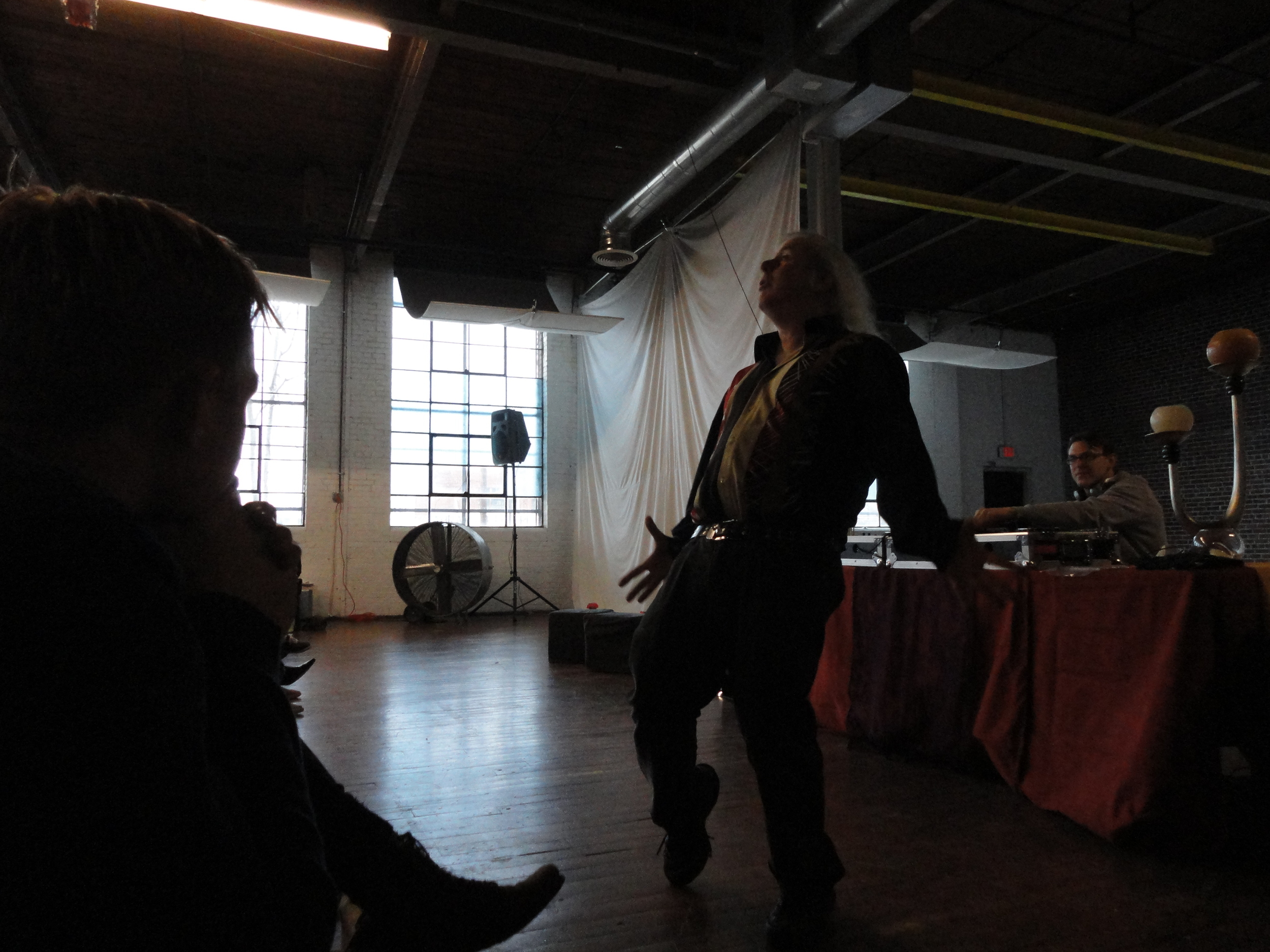I went to Swing & Soul last weekend. It was big fun. That's all I have to say about that. Usually event reviews detail the music, venues, and classes in order to give a recommendation or not. But what's the point in this case? I don't make it a secret that I've worked for Tena Morales (one of the event directors along with Manu Smith and Peter Strom) on afewevents, so most anything I say has to be taken with a grain of salt. Or at least it should be.
Besides, this event ain't happening again any time soon. The organizers just have too much on their plate to put on what is essentially just a party. But that's what made it such a fun time.
Think about this for a second. A couple of years ago, Tena organized or co-organized the following in the span of one year
- August, 2008-The first ILHC
- December, 2008-The 2nd Swing & Soul
- January, 2009-The 2nd Lone Star Championships
- March, 2009-The 13th Lindyfest
- May, 2009-The onlyFrankie95
- August, 2009-2nd ILHC
Dude, I don't even go to six events in a year. And these aren't small events either. These are big honkin' conflagrations.
She's also a damn fine dancer and teacher
Despite that, Tena does a good job of making sure each event she does has a slightly different flavor to it. Swing & Soul is probably the most distinctive of them all. Not just in terms of music, but it's focus as a more casual gathering. Any place that serves buffet style full scale meals is going to have a more family feel to it for me.
In fact there, I felt a slight urge to be more involved with the event than just being there just from watching everyone in the kitchen shoot the shat while getting the food together for each late night. Tena has a knack for getting together groups of fun hard working people or at least hard workers that know how to have fun.
It’s the reason why I didn't mind too much paying to go at the last minute. I've had a lot going on, so I wasn't sure I was good to go until last Thursday night, just under 24 hours before I landed in Atlanta. I went mostly to be with friends I don't get to see often enough anymore. Swing & Soul reminded me of the kind of people that I enjoy being around.
People I like
I was thinking about these different kinds of people as I was observing Stephen Jean teach the Walk The Walk class where he broke down the supermodel catwalk. It sounds stupid, but he has a great eye for movement and did a great job of stripping down the way you walk to its bare essentials; then slowly add different layers so you could have been working it like a diva by the end of the hour. Or at least understand how different ways of carrying yourself and placing your feet affects your motion.
As I watched the class, I noticed that some people were just not doing it. Actually, they were not doing anything they were being told. I don’t know if they weren’t paying attention or were just unaware, but quite a few of them were moving in the same way at the end of the as they were from the beginning. I don’t know how that was possible because we’re talking about walking here. The instructions were not complicated.
I was watching the class with Skye Humphries, and even though he admitted that the overall affect was actually quite difficult to achieve-and he did try-there should have been some difference in the way people were moving every time Stephen Jean introduced another element.
Generally speaking, the people I noticed in the class that were paying attention and getting it were at least better than average Lindy Hoppers. Interestingly enough, even though he didn’t quite get it, Skye was able to pinpoint what he was doing wrong at different moments. It’s this awareness of self that I tend to admire in my friends and people I respect. People tend to think that Skye's movement comes naturally to him, but he constantly thinks about it and notices little things, mostly flaws. At one point we were looking at fliers and he made a crack about his hunched shoulders on the latest Lindyfest advertisements.
As long as I’ve known Skye, I’ve actually never taken a formal class from him. (I did a group private lesson once to get him and Naomi to show us some Charleston stuff many, many years ago, but that’s about it) The funny thing is that when we talk about the state of his teaching, up until recently, he usually makes it sound like he’s the worst instructor in the history of education. However, right before I left Atlanta, I had lunch with Marie Mattsson, who has taught with Skye a few times, and she had nothing but great things to say about his teaching style. She didn’t just say that just because she enjoys working with him, but there’s a genuine admiration for the way he is able to break down and communicate abstract dance concepts.
Skye and I had dinner with Kim Clever and David Frutos on Saturday. They’re from Southern California and David was one of the DJ’s for the weekend. I’ve only spoken to them once before, at the first ILHC in 2008. But I got to know them some more this weekend, and it was interesting to get their perspective on the scene from that side of the country. I've written before on how it feels like SoCal is another world in the way they approach the dance. Kim even talked about how they just did a contest this year where they didn’t do any aerials. She noted how much of a novelty experience it was for them. And they’ve been dancing since the 90’s.
They also mentioned how they were going to give it at least one more year to throw some sh!t down on the dance floor. This is impressive to me because they have a few years on me, and I’m not that young. They go into this fully knowing that they don’t match up very well to the younger dancers out there, but they don’t seem to care. They feel like they have nothing to lose and are thoroughly unconcerned that they don’t have that much more to gain. They just want to do it just to do it.
I wish there were more dancers like that. Hard to believe from this blog, but I do think that there is a point where you can take yourself and the dance too seriously. That balance was brought into focus in my favorite part of the weekend which was listening to talks by author Rob Bowman and legendary bassist Bob Babbitt.
DSC02408
Bob Babbit has played bass on over 200 Top 40 hits. As one of The Funk Brothers, his bass lines backed up Smokey Robinson, Stevie Wonder, Marvin Gaye and a host of others. At one point while he was talking, he casually mentioned that the bass he was holding in his hands was The Bass-the bass he used to play on Stevie Wonder’s “Signed, Sealed, and Delivered” and Glady Knight’s “Midnight Train to Georgia.” We just stared at him in hushed silence wondering how he could carry that thing around with him. Turns out he was taking it to a special gig with Phil Collins right after Swing & Soul. But he wasn’t always sentimental about the instrument. He confessed that after he took out an insurance policy on it, he would sometimes linger after putting it through airport security. He halfway hoped that someone would steal it, so he could cash in on it since times haven’t always been good. Thankfully, he's grown more attached to it since then.
It was interesting to hear him talk about those early days with Motown, and how they didn’t think it wasn’t much of a big deal. Recording these songs now ingrained into our cultural consciousness were just random gigs in the basement of a house at the time. It was a job. A fun job at times, but a job they did well.
I remember him using the word “discipline” over and over again when referring to the way he approached playing music, no matter what the context. He joked about the difference in his approach to playing for diverse talents from the likes of Tony Bennett to Jimi Hendrix to Marvin Gaye-which was no difference at all other than the way he dressed. Discipline above all else was key for him to make money or to just enjoy what he does.
Rob Bowman did a great job of giving us a musical and historical tour of the development of soul music. He has a great enthusiasm for and an encyclopedic knowledge of the music and the musicians. I kinda want to be him when I grow up.
DSC02406
He not only brought in a rare demo recording of the Staples Singers doing an early version of “I’ll Take you there,” but then proceeded to blow our minds when he dug up the original reggae inspiration for that song. A song so rarely heard that he shocked one of the Staples Singers with it because up until he played it for them, they swore that they thought they originally wrote the song.
It was also amazing the way he could break down a song like “Heat Wave” into its component parts and detail how each instrument and each creative decision could make what sounds like a simple throw away pop song into a tightly orchestrated, multi-layered musical master piece.
I was particularly intrigued by the was he compared the music making cultures of Motown in Detroit to Stax down in Memphis. Motown was a regimented, well oiled machine while Stax reflected a more leisurely Southern attitude. The Funk Brothers in Motown worked under tight deadlines under very strict guidance from producers and engineers. Meanwhile, down at Stax, Booker T & The MG’s would play all day with their vocalists, and often times still record glaring mistakes which they made work
Check out Sam & Dave’s "Hold On" and notice the muted trumpet that backs up the chorus line disappears around the 1:00 mark. That was a mistake, but the recording was so good, they decided to go with it anyway. That’s just how Stax rolled.
This is just an example of how there are no definitive recipes for success or even fun. It can come from a variety of approaches. It’s too bad this event isn’t going to happen again because Swing & Soul was a great place to learn these lessons.












